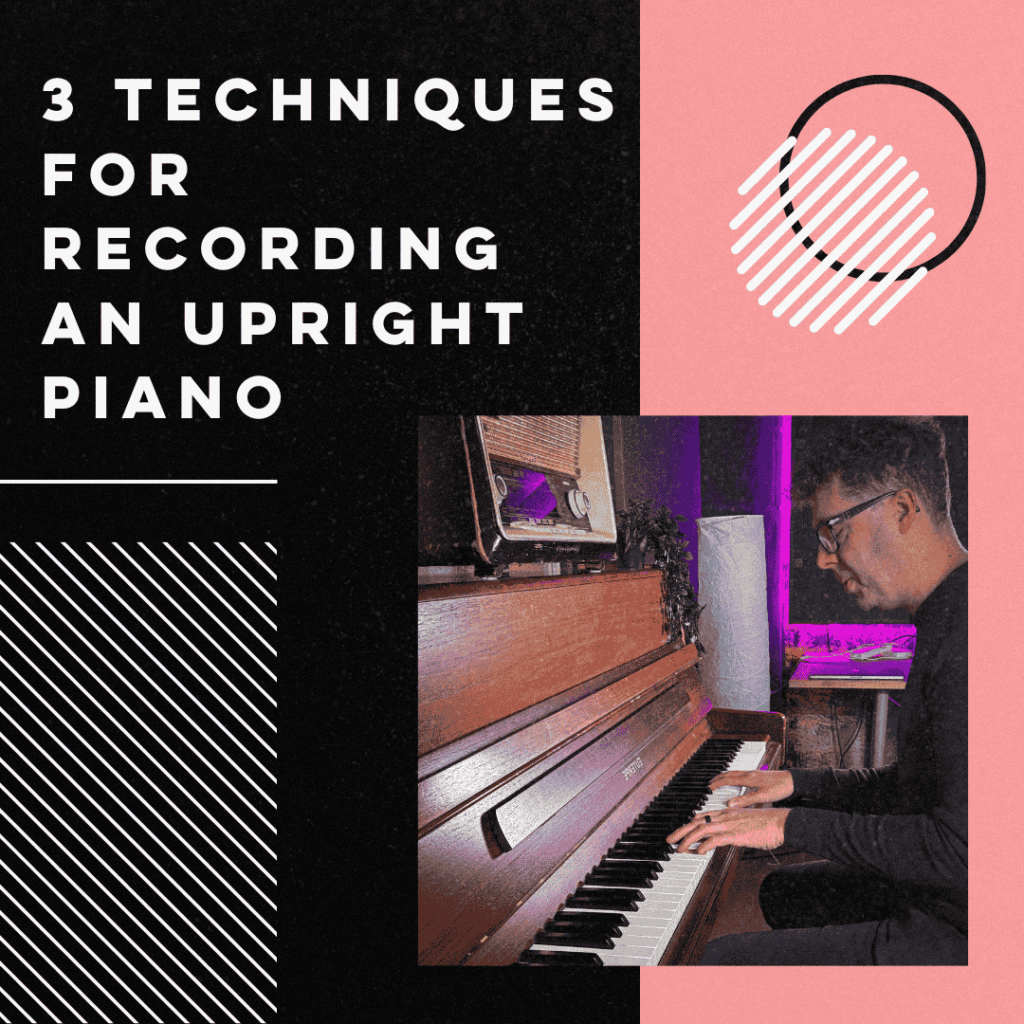Recording an upright piano can bring out the beautiful complexity of the instrument, but capturing that sound accurately requires the right microphone techniques. In this blog post, we’ll explore three popular ways of recording an upright piano using two condenser microphones for each method. Each approach brings a unique tonal quality and stereo image to the table. Whether you want an intimate sound or a spacious stereo field, these techniques offer plenty of options to explore.
1. Close Mic Technique: Intimacy and Detail
How it works: The close mic technique involves placing the microphones close to the piano’s strings. Typically, one microphone is positioned near the bass strings (lower part of the piano) and the other near the treble strings (upper part). This proximity to the sound source allows the microphones to capture a highly detailed and intimate recording.
Best for: This technique is perfect when you want the listener to feel as if they are right next to the piano. It’s often used in genres like jazz, pop, or intimate solo performances where clarity and detail are paramount.
Sound characteristics:
- Detailed and focused sound: By being close to the strings, this method captures the nuances of the hammer striking the strings and the overtones that give the piano its character.
- Less room sound: Because the microphones are so close, you’ll pick up less of the room’s acoustics and more of the instrument itself. This can be advantageous in environments with less-than-ideal acoustics.
- Greater control: In post-production, you have more flexibility to shape the sound since you’re working with a dry, isolated recording.
2. Spaced Pair Technique: Spacious and Natural
How it works: In the spaced pair technique, the microphones are moved further away from the piano, spaced apart to capture a wider, more open sound. The placement is often several feet away from the instrument, which allows the mics to pick up more of the piano’s natural resonance and the room’s acoustics.
Best for: This technique is great for classical music or any genre where you want the piano to feel like it’s part of a larger space. It’s also ideal when you’re looking for a natural and immersive stereo image.
Sound characteristics:
- Wider stereo field: Since the microphones are spaced apart, they capture different parts of the instrument, giving the listener a sense of width and depth.
- More room sound: By pulling back from the piano, the microphones pick up not only the instrument but also the reflections in the room. This can add a sense of realism and depth to the recording.
- Less detailed but more ambient: While you may lose some of the immediate detail captured by the close mic technique, you gain a more natural and organic sound that works well in ensemble settings or ambient recordings.
3. X/Y Technique: Balanced and Cohesive
How it works: The X/Y technique is a coincident pair setup where the microphones are placed close together, but angled outward to create a stereo image. In the case of the upright piano, the mics are usually positioned in the center of the instrument, aimed at the strings. This creates a balanced stereo recording with minimal phase issues.
Best for: This technique is often used when you want a clean, balanced recording that sits well in a mix. It’s also great for genres that require clarity and precision, like classical or even certain types of modern pop.
Sound characteristics:
- Tight and balanced stereo image: The X/Y method provides a clear stereo image without the risk of phase cancellation (which can happen with spaced microphones). This means you get a more focused and coherent sound.
- Consistent tone: Since the microphones are positioned closely together, they capture a similar tonal range, leading to a cohesive and unified sound across the stereo spectrum.
- Controlled room sound: While you still capture some room acoustics, the X/Y technique tends to focus more on the instrument itself, making it a versatile option for various recording environments.
Choosing the Right Technique
Each of these microphone techniques brings a different flavor to your piano recordings:
- If you’re aiming for clarity and intimacy, the close mic technique will be your best bet.
- For a wider, more natural sound, the spaced pair technique offers a more open, airy recording.
- The X/Y technique strikes a great balance, offering a cohesive stereo image with minimal phase issues, perfect for clean and balanced recordings.
Conclusion
Every microphone technique has its place in music production, and the right one for you depends on the sound you’re going for. Whether you want to showcase every detail of the piano or capture the ambiance of the room, experimenting with these setups can help you find the perfect tone for your project.

